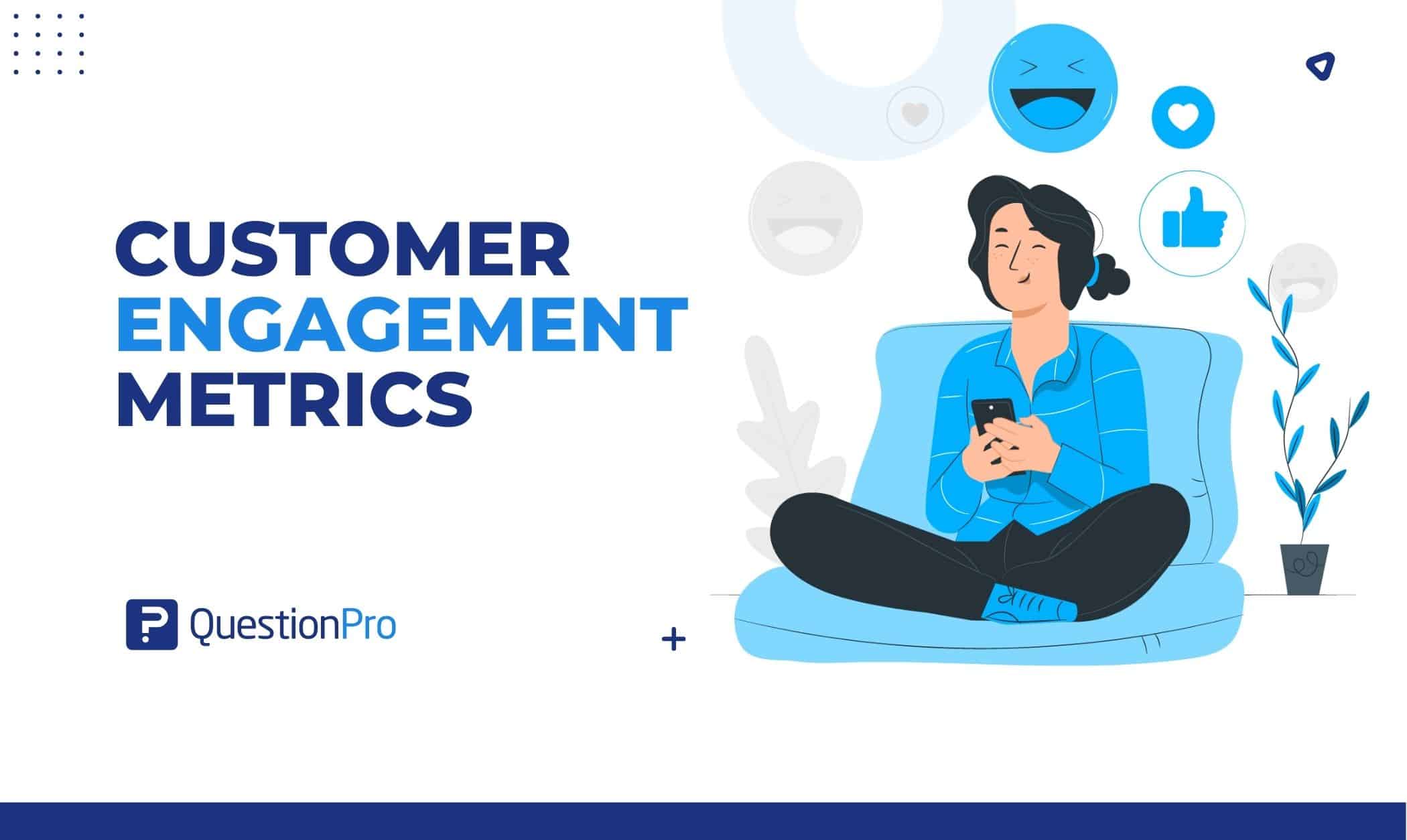
The lifeblood of any business is always happy customers. They are the driving forces behind the growth and success of brands. And businesses that track customer engagement frequently provide excellent service.
As a result, all of your engagement efforts would be futile if you did not track how customers interacted with your brand.
Track your customer engagement metrics on an ongoing basis. Because customers can engage through various channels, it’s important to track metrics from all of them to get a bird’s eye view of the audience.
This blog will discuss customer engagement metrics and how to measure engaged customers for your business.
What are customer engagement metrics?
Metrics for measuring user involvement in your business are called customer engagement metrics. These metrics help you determine whether your marketing strategies are paying off and whether your customers’ expectations are being met.
Here is a list of the most important customer satisfaction metrics that will make your customers much more interested:
- Net Promoter Score (NPS)
- Customer Satisfaction Score (CSAT)
- Customer Lifetime Value (CLV or LTV)
- Customer Health Score
- Daily Active Users (DAU)
- Conversion Rate
- Feature Uses
- Shares
- Page Views
- Churn Rate
10 Key Customer Engagement Metrics
Customer engagement is all about generating excitement and interest in your brand so that customers want to be associated with it not just because they like your product or service but also because they like you.
Here are the 15 most effective customer engagement metrics for developing a successful customer engagement strategy:
1. Net promoter score
The Net Promoter Score (NPS) is one of the most effective customer engagement metrics to assess customer loyalty and happiness. It is also one of the simplest metrics to apply. Collect customer feedback by asking if they would recommend your service to their friends, family, or coworkers. Then, ask them to rate you on a scale of 1 to 10.
Detractors are those who give your company a score of 0 to 6, are completely dissatisfied with it and may spread rumors about it.
Passive scores fall between 7-8. Most of the time, their user experience has been positive; however, they are not enthusiastic enough about your service to recommend it to others. In the future, they could easily switch to your competitor.
Promoters have a score of 9-10 and are eager to spread the word about your company. They are the most frequent users of your products or services.
Tools to Measure NPS:
- QuestionPro CX
- AskNicely
- Typeform
2. Customer satisfaction score (CSAT)
Customer satisfaction (CSAT) is a key performance indicator for improving customer success and product quality. You can use customer satisfaction scores after a phone call, online purchase, etc.
If you understand your measuring spectrum, you can be more creative with your options. CSAT measures how easy or difficult it is for a customer to complete tasks with your product or service. They can give you a number based on their experience, or you can customize your CSAT by adding smiley faces or emojis.
Tools to Measure CSAT
- QuestionPro CX
- NiceReply
- BirdEye
3. Customer lifetime value (CLV Or LTV)
The customer lifetime value (CLV or LTV) calculates how much revenue you will make from a customer throughout their subscription. CLV assists in calculating your customer acquisition cost (CAC) and what you may lose if your customer churn increases.
Customer lifetime value depends on how often they buy, how much they spend, and how long they stay active. It would help to consider how much it costs to acquire a single customer and whether this is justified.
Tools to Measure CLV:
- QuestionPro CX
- Unbounce
- HubSpot
4. Customer health score
A customer health score is a customer engagement metrics used to predict whether a customer will stay, engage, or churn. This metric helps customer success teams by bridging the gap between the team and the customers.
Customer health scores have become increasingly important for SaaS companies in recent years. It is because this metric provides useful information about how a customer interacts with your SaaS product. You can determine whether they are getting the most out of your service, utilizing all available features, and so on.
They are more likely to churn if they are not taking action with your product. Measuring your customer health score is dependent on several factors, including:
- Describe the outcome depending on your company’s objectives.
- define the customer segments to which the health score applies.
Tools to Measure Customer Health Score:
- QuestionPro CX
- Gainsight
- Custify
5. Daily active users (DAU)
For SaaS companies, daily active users (DAU) are the total number of users who use your product daily. Users who open and look at your product are considered active. This metric is especially important for assessing the health of your product because it tracks the number of unique users who use it.
Remember that the daily active user metric only shows how many people open or view your product. You can expect this metric to rise when you launch and market a new product.
6. Conversion rate
There are several customer engagement metrics that help customers to engage with your brand measurement. Every touchpoint for a SaaS business is another possible gateway for your audience to interact with you. These points can be used as data to monitor your conversion rate, from the end goal to the completed action. These actions include:
- Buying your products or services
- Downloading your book, software, or customer lead magnet
- Form submission
- Website interaction
Conversion rate is the number of visitors who complete the desired goal as a percentage of all visitors. It shows who completed the action and who didn’t. To figure out your conversion rate, divide the number of conversions by the total number of interactions during the same time frame.
Conversions are ultimately tied to how profitable your brand is as a whole. Still, they are helpful in understanding and improving customer retention.
Keep an eye on this metric to ensure your content marketing strategies are working well, and use this data over time to fix any problems.
Tools to Measure Conversion Rate:
- Google Analytics
- Hotjar
7. Feature use
Measuring feature usage can reveal which components of your product or service people frequently use (or do not utilize). SaaS and eCommerce organizations can improve their essential features and solutions with this statistic.
Similar to feature use, feature adoption aims to determine whether or not users interact with a particular product feature. Is this feature valued? Is it hard to use? Feature adoption analyzes user behavior. It fixes poor feature adoption rates immediately.
Sharing is also caring for SaaS businesses. So, how many people can relate to or get ideas from your content depends on how many people share it.
Sharing is one of the most influential customer engagement metrics, despite being overlooked as a vanity metric. Sharing relatable and interesting content with others helps your website grow organically.
9. Page views
Tracking page views are useful for determining how many times users have visited a specific page on your website. This metric allows you to determine how much traffic your website receives in a given time.
Google Analytics is the simplest way to track page views. Most website tracking tools will provide you with this feature for free.
10. Churn rate
The churn rate is the number of SaaS customers who stop paying for their subscriptions over time. ProfitWell estimates that the average SaaS churn rate is between 3% and 8%.
To calculate your customer churn rate, divide the number of churned customers by the number of customers you acquired at the start of the period. The percentage is then calculated by multiplying that amount by 100.
It is the nature of any business for some customers to abandon your product or service for a variety of reasons. However, if you consistently lose customers and revenue, your strategies will fail at some point, reducing your company’s viability. That is why it is critical to keep customer churn to a minimum.
Tools to Measure Churn Rate
- QuestionPro CX
- Hotjar
Conclusion
To summarize, tracking customer engagement metrics is critical to your success. Understanding how and why customers engage with your website and brand will make it easier to tweak the areas that require improvement. Remember that they will go to your competitors if you do not provide a great customer experience.
QuestionPro is a survey software and research platform that assists businesses and organizations in gathering customer and employee feedback.
QuestionPro CX lets you use Net Promoter Score (NPS), Customer Satisfaction Score (CSAT), and Customer Effort Score (CES) to measure customer satisfaction (CES).
QuestionPro CX gives you the most innovative and easy-to-use CX tool belt on the market for research, so you can get insights that you can use. It is designed to help you turn your customers into brand advocates.







